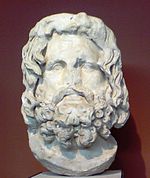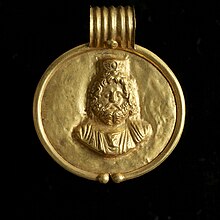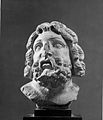塞拉比斯
此條目需要補充更多來源。 (2019年9月1日) |


塞拉比斯(拉丁語:Serapis、古希臘語:Σάραπις)或譯塞拉皮斯是希臘化時代的埃及神祇,是一個希臘-埃及複合神。公元前3世紀,托勒密王朝的法老托勒密一世將對塞拉皮斯的祭祀作為統治希臘人和埃及人的一種手段。[1]祭祀塞拉皮斯的神廟或宗教區域被稱作塞拉潘。托勒密王朝君主非常重視塞拉皮斯的祭祀,亞歷山大港的塞拉潘是最有名的塞拉皮斯神殿。391年,神殿被亞歷山卓主教提阿非羅(Theophilus)拆毀。塞拉皮斯在羅馬帝國期間繼續流行,在埃及以外的神廟內經常取代奧西里斯作為伊西斯的配偶。
塞拉皮斯被描繪成希臘人的外貌與埃及式的服飾,並融合了來自許多不同信仰中的肖像,象徵着富裕和復興。雖然可能是托勒密一世製造了對塞拉皮斯的官方崇拜,並認可他為托勒密王朝和亞歷山大的守護神,塞拉皮斯實際上是一個複合神,源於對埃及神祇奧西里斯和阿匹斯的崇拜[2],還融合了其他一些神的設定,如與希臘的哈迪斯和得墨忒耳有關的克托尼俄斯之力,與狄俄倪索斯有關的慈悲。
有證據表明,在托勒密於亞歷山大掌權之前,塞拉皮斯的祭祀就已經存在:公元前323年,普魯塔克[3]和阿里安[4]都提到了埃及的塞拉皮斯神廟。主流的托勒密「創造」此神的說法來源於記錄他在亞歷山大建造塞拉皮斯雕像的資料:「這座雕像通過包含埃及和希臘風格的塑造豐富了塞拉皮斯的概念。」[5]
名字與起源
[編輯]
「Sarapis」是古希臘語中最常見的形式,直到羅馬時代,「Serapis」才變得普遍。[7][8]
最著名的塞拉皮斯神廟是亞歷山大的塞拉潘。[9]在托勒密一世的統治下,人們努力將埃及宗教與希臘統治者的宗教結合起來。托勒密的政策是找到一個同時贏得兩個團體敬仰的神,而不管埃及祭司有針對前外國統治者的神的詛咒(例如喜克索斯人崇拜的賽特)。亞歷山大大帝曾試圖用阿蒙來達到這一目的,但他雖在上埃及做得很成功,在下埃及卻不那麼受歡迎,因為在下埃及,希臘人的影響力更大。
希臘人幾乎不推崇動物頭像式樣的物品,因此其偶像採用希臘風格的擬人雕塑,並宣布與當時十分流行的阿匹斯地位同等。[10] 它被命名為Userhapi(即「Osiris-Apis」,奧西里斯-阿匹斯),後來成為希臘語中的Sarapis,據稱是奧西里斯的完全形態,而不僅僅是他的卡(靈魂)。
歷史
[編輯]圖冊
[編輯]-
塞拉皮斯頭像,公元前1世紀,布魯克林博物館
-
Head of Serapis, Carthage, Tunisia
-
帶有塞拉皮斯半身像的油燈,兩側是新月和星星(羅馬時期的以弗所,100-150年)
-
可能是塞拉皮斯雕像(但注意它有赫拉克勒斯的棒),貝格拉姆,阿富汗
-
塞拉皮斯頭像(150–200年)
-
塞拉皮斯頭像,來自亞歷山大海岸外一座12英尺高的雕像。
-
羅馬埃及的塞拉皮斯,亞歷山大,比隆四德拉克馬銀幣
-
希臘羅馬時代的陶器,斯塔特利克博物館,埃及藝術區,慕尼黑
參考資料
[編輯]- ^ "Sarapis" in The New Encyclopædia Britannica. Chicago: Encyclopædia Britannica, Inc., 15th edn., 1992, Vol. 10, p. 447.(英文)
- ^ Youtie, H. 1948. 「The Kline of Serapis」. The Harvard Theological Review, vol 41, pp. 9–29.
- ^ Life of Alexander, 76
- ^ Anabasis, VII, 26, 2
- ^ Stambaugh, John E. Sarapis Under the Early Ptolemies. Leiden: E. J. Brill. 1972: 1–13 [2019-01-19]. (原始內容存檔於2022-04-07).(英文)
- ^ 詹姆斯·M·莫里斯. 美國軍隊及其戰爭. [2019-01-19]. (原始內容存檔於2021-03-02).
- ^ Consulting the unabridged Lewis and Short Latin lexicon shows that "Serapis" was the most common Latin version of the name in antiquity: Serapis (頁面存檔備份,存於網際網路檔案館). Charlton T. Lewis and Charles Short. A Latin Dictionary on Perseus Project. Lewis, Charlton; Short, Charles. A Latin Dictionary. Oxford: Oxford University Press. 1879: 1630. A Latin Dictionary. : 1678. On the Internet Archive.(英文)
- ^ E.g. CIL 03, 07768; CIL 03, 07770; CIL 08, 12492. All known occurrences can be found at http://db.edcs.eu/epigr/epi.php?s_sprache=de (頁面存檔備份,存於網際網路檔案館).(德文)
- ^ "Of the Egyptian sanctuaries of Serapis the most famous is at Alexandria", Pausanias noted (Description of Greece, 1.18.4, 2nd century AD), in describing the Serapeion at Athens erected by Ptolemy on the steep slope of the Acropolis: "As you descend from here to the lower part of the city, is a sanctuary of Serapis, whose worship the Athenians introduced from Ptolemy."
- ^ According to James George Frazer's note to the Biblioteca of Pseudo-Apollodorus, 2.1.1: "Apollodorus identifies the Argive Apis with the Egyptian bull Apis, who was in turn identified with Serapis (Sarapis)"; Pausanias also conflates Serapis and Egyptian Apis: "Of the Egyptian sanctuaries of Serapis the most famous is at Alexandria, the oldest at Memphis. Into this neither stranger nor priest may enter, until they bury Apis" (Pausanias,Description of Greece, 1.18.4).








